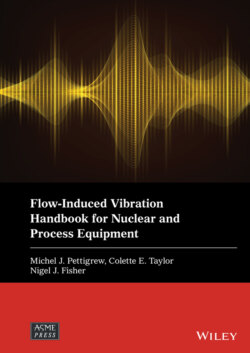Читать книгу Flow-Induced Vibration Handbook for Nuclear and Process Equipment - Группа авторов - Страница 25
2.2.1 Flow Parameter Definition
ОглавлениеThe end results of a flow analysis are the shell‐side cross‐flow velocity, Up, and fluid density, ρ, distributions along critical tubes. For flow‐induced vibration analyses, flow velocity is defined in terms of the pitch velocity:
(2‐1)
where U∞ is the free stream velocity (i.e., the velocity that would prevail if the tubes were removed), P is the pitch between the tubes and D is the tube diameter. For finned tubes, the equivalent or effective diameter, Deff, is used. The pitch velocity is sometimes called the reference gap velocity. The pitch velocity is a convenient definition since it applies to all bundle configurations.
The situation is somewhat more complex in two‐phase flow. Another parameter, steam quality or void fraction, is required to define the flow conditions. Two‐phase mixtures are rarely homogeneous or uniform across a flow path. However, it is convenient and simple to use homogeneous two‐phase mixture properties as they are well defined. This is done consistently here for both specifying vibration guidelines and formulating vibration mechanisms. The homogeneous void fraction, εg, is defined in terms of the volume flow rates of gas, , and liquid, as:
(2‐2)
The homogeneous density, ρ, the free stream velocity, U∞, and the free stream mass flux, are defined using the homogeneous void fraction:
(2‐3)
(2‐4)
(2‐5)
where ρg and ρℓ are the densities of the gas and liquid phase, respectively, and A is the free‐stream flow path area.
For both liquid and two‐phase cross flow, the pitch velocity, Up, and the pitch mass flux, , are similarly defined as:
(2‐6)
